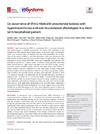Identificador persistente para citar o vincular este elemento:
https://accedacris.ulpgc.es/handle/10553/132219
| Título: | Co-occurrence of ST412 Klebsiella pneumoniae isolates with hypermucoviscous and non-mucoviscous phenotypes in a short-term hospitalized patient | Autores/as: | Liang, Qinghua Chen, Nan Wang, Wei Zhang, Biying Luo, Jinjing Zhong, Ying Zhang, Feiyang Zhang, Zhikun Martín Rodríguez, Alberto Jonatan Wang, Ying Xiang, Li Xiong, Xia Hu, Renjing Zhou, Yingshun |
Clasificación UNESCO: | 320103 Microbiología clínica | Palabras clave: | Capsular Polysaccharide Biofilm Formation Escherichia-Coli Liver-Abscess Virulence, et al. |
Fecha de publicación: | 2024 | Publicación seriada: | mSystems | Resumen: | La hipermucoviscosidad (HMV) es un fenotipo que se asocia comúnmente con la hipervirulencia en Klebsiella pneumoniae . Los factores que contribuyen a la aparición de subpoblaciones de HMV siguen sin estar claros. En este estudio, se recuperaron ocho cepas de K. pneumoniae de un paciente hospitalizado que había estado internado durante 20 días. Tres de los aislamientos exhibieron un fenotipo no HMV, que fue concomitante con una mayor formación de biopelícula que los otros cinco aislamientos HMV. Los ocho aislamientos fueron altamente susceptibles a la muerte sérica, aunque las cepas HMV fueron notablemente más infecciosas que sus contrapartes no HMV en un modelo de infección en ratones. La secuenciación del genoma completo (WGS) mostró que los ocho aislamientos pertenecían al linaje K57-ST412. El análisis de identidad de nucleótidos promedio (FastANIb) indicó que ocho aislamientos comparten entre el 99,96% y el 99,99% de similitud y se confirmó que eran el mismo clon. A través del análisis genómico comparativo, se encontraron 12 mutaciones no sinónimas entre estos aislamientos, ocho de las cuales en las variantes no-HMV, incluyendo rmpA (c.285delG) y wbaP (c.1305T > A), que se supone que están asociadas con el fenotipo no-HMV. Las mutaciones en manB (c.1318G > A), dmsB (c.577C > T) y tkt (c.1928C > A) ocurrieron solo en aislamientos HMV. RNA-Seq reveló que las transcripciones de genes involucrados en el metabolismo energético, el metabolismo de carbohidratos y el transporte de membrana, incluyendo cysP , cydA , narK , tktA , pduQ , aceB , metN y lsrA , estaban significativamente desregulados en las cepas no-HMV, lo que sugiere una contribución al desarrollo del fenotipo HMV. Este estudio sugiere que la coocurrencia de fenotipos HMV y no HMV en la misma población clonal puede estar mediada por mecanismos mutacionales así como por ciertos genes involucrados en el transporte de membrana y el metabolismo central. Hypermucoviscosity (HMV) is a phenotype that is commonly associated with hypervirulence in Klebsiella pneumoniae. The factors that contribute to the emergence of HMV subpopulations remain unclear. In this study, eight K. pneumoniae strains were recovered from an inpatient who had been hospitalized for 20 days. Three of the isolates exhibited a non-HMV phenotype, which was concomitant with higher biofilm formation than the other five HMV isolates. All eight isolates were highly susceptible to serum killing, albeit HMV strains were remarkably more infective than non-HMV counterparts in a mouse model of infection. Whole genome sequencing (WGS) showed that the eight isolates belonged to the K57-ST412 lineage. Average nucleotide identity (FastANIb) analysis indicated that eight isolates share 99.96% to 99.99% similarity and were confirmed to be the same clone. Through comparative genomics analysis, 12 non-synonymous mutations were found among these isolates, eight of which in the non-HMV variants, including rmpA (c.285delG) and wbaP (c.1305T > A), which are assumed to be associated with the non-HMV phenotype. Mutations in manB (c.1318G > A), dmsB (c.577C > T) and tkt (c.1928C > A) occurred in HMV isolates only. RNA-Seq revealed transcripts of genes involved in energy metabolism, carbohydrate metabolism and membrane transport, including cysP, cydA, narK, tktA, pduQ, aceB, metN, and lsrA, to be significantly dysregulated in the non-HMV strains, suggesting a contribution to HMV phenotype development. This study suggests that co-occurrence of HMV and non-HMV phenotypes in the same clonal population may be mediated by mutational mechanisms as well as by certain genes involved in membrane transport and central metabolism. IMPORTANCE K. pneumoniae with a hypermucoviscosity (HMV) phenotype is a community-acquired pathogen that is associated with increased invasiveness and pathogenicity, and underlying diseases are the most common comorbid risk factors inducing metastatic complications. HMV was earlier attributed to the overproduction of capsular polysaccharide, and more data point to the possibility of several causes contributing to this bacterial phenotype. Here, we describe a unique event in which the same clonal population showed both HMV and non-HMV characteristics. Studies have demonstrated that this process is influenced by mutational processes and genes related to transport and central metabolism. These findings provide fresh insight into the mechanisms behind co-occurrence of HMV and non-HMV phenotypes in monoclonal populations as well as potentially being critical in developing strategies to control the further spread of HMV K. pneumoniae. |
URI: | https://accedacris.ulpgc.es/handle/10553/132219 | ISSN: | 2379-5077 | DOI: | 10.1128/msystems.00262-24 | Fuente: | Msystems [ISSN 2379-5077], (2024) |
| Colección: | Artículos |
Citas de WEB OF SCIENCETM
Citations
3
actualizado el 08-jun-2025
Google ScholarTM
Verifica
Altmetric
Comparte
Exporta metadatos
Los elementos en ULPGC accedaCRIS están protegidos por derechos de autor con todos los derechos reservados, a menos que se indique lo contrario.
